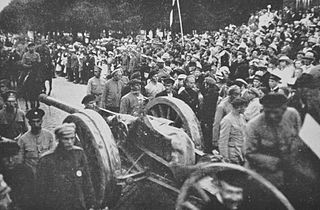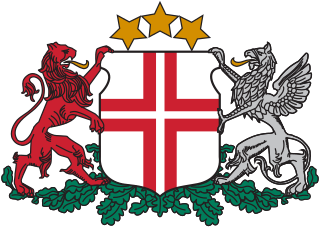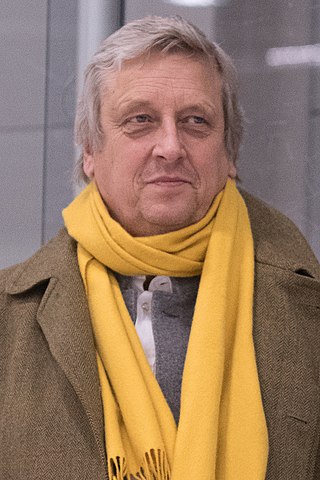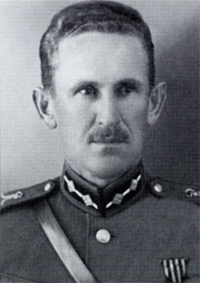
Liepāja is a state city in western Latvia, located on the Baltic Sea. It is the largest city in the Kurzeme Region and the third-largest in the country after Riga and Daugavpils. It is an important ice-free port.

Lāčplēsis is an epic poem by Andrejs Pumpurs, a Latvian poet, who wrote it between 1872 and 1887 based on local legends. It is set during the Livonian Crusades telling the story of the mythical hero Lāčplēsis "the Bear Slayer". Lāčplēsis is regarded as the Latvian national epic.
The rock opera Lāčplēsis is a Latvian musical based on the Latvian national epic Lāčplēsis. The libretto was written in 1986/87 by Māra Zālīte, with music composed by Zigmārs Liepiņš. It premiered in Riga on 23 August 1988. According to Māra Zālīte's homepage there were 43 shows, each attended by 4,000 people.

Dobele is a town in the cultural region Zemgale in Latvia, and is located near the center of Latvia on the banks of the river Bērze. It received town rights in 1917 whilst being a part of the German occupied Courland Governorate during the First World War. As of 2020, the population was 8,856.
Jānis Liepiņš was a Latvian painter from Riga. He studied at Jūlijs Maderniek's studio in Riga between 1909 and 1910, at the Kazan Art School 1911–1913, and at Marcus Bernstein's studio in St Petersburg 1913–1917. He was a member of the Riga Artists' Group and professor of painting at the Art Academy of Latvia 1940–1950. During the 1920s Liepiņš was active in the left-wing press.

The Latvian War of Independence, sometimes called Latvia's freedom battles or the Latvian War of Liberation, was a series of military conflicts in Latvia between 5 December 1918, after the newly proclaimed Republic of Latvia was invaded by Soviet Russia, and the signing of the Latvian-Soviet Riga Peace Treaty on 11 August 1920.
HK Liepājas Metalurgs was a professional hockey club based in Liepāja, Latvia that fielded multiple teams over the years competing in the Belarusian Extraliga (BXL), Latvian Hockey League (LHL), and Minor Hockey League Division B. The club was dissolved following the conclusion of the 2012-13 season when primary sponsor, industrial company Liepājas Metalurgs, discontinued support for the club.
Roberts Skadats is a former Latvian football midfielder and forward who played with FK Daugava Rīga for most of his career.
Aivars Leimanis was a Latvian ballet dancer and is now the Artistic Director of Latvia’s National Ballet. His daughter is the ballet dancer, Elza Leimane.

The Ronis-class submarines were built for the Latvian Navy in France in 1925. They were acquired by the Soviets in 1940 following the annexation of Latvia by the Soviet Union. They were scuttled in Liepāja in June 1941 as the Germans were about to capture the port. The hulls were raised in 1942 and scrapped.

Latvian Naval Forces is the naval warfare branch of the National Armed Forces. It is tasked with conducting military, search and rescue operations, mine and explosive sweeping on the Baltic Sea, as well as ecological monitoring activities. The Naval Forces have participated in international NATO/Partnership for Peace operations and various exercises with great success. The main development priorities of the Naval Forces are to expand their activities within the Baltic States’ Ship Squadron BALTRON and to develop a Sea Surveillance System. They pay a great deal of attention to professionally specialized training and English-language teaching.

Zigmars Liepiņš (born 14 October 1952 in Liepāja, Latvian SSR, USSR is a Latvian composer, keyboard player and the chairman of the board for the Latvian National Opera. Liepiņš has written songs for choirs, solo artists, orchestras, films, theatres, and operas.

Microphone Records is a Latvian record label and distribution company founded in 1993 by professional radio journalist Elita Mīlgrāve and professional record producer and musician Guntars Račs. Since 1996, Microphone Records has a license agreement with the EMI Group on promoting and marketing EMI and Virgin artists in the Baltic states.

Ludvigs Bolšteins was a Latvian general. From 1925 to 1928 Bolšteins was commander of the Aizsargi home guard, from 1928 to 1940 commander of the Latvian border guard. He killed himself following the Soviet occupation of Latvia.
Notre-Dame de Paris is a Latvian operatic melodrama by Zigmars Liepiņš. The libretto by Kaspars Dimiters is based on motifs from Victor Hugo's 1831 novel The Hunchback of Notre-Dame.

Rodrigo Fomins better known by the stage name Igo is a Latvian singer, poet and composer of rock and other music styles.
Laimdota is a feminine Latvian given name, borne by over 600 individuals in Latvia. Its name day is February 11.

Jānis Liepiņš is a Latvian conductor. Since 2014 he has been the conductor at the Latvian National Opera and Ballet (LNO). For the LNO, he has conducted productions of Il trovatore (2014), Le Villi and Gianni Schicchi (2015), Eugene Onegin (2016), Romeo and Juliet (2014), Scheherazade And Her Tales (2016), and La Bayadère (2012), and was both the conductor and musical director for the ballet Raymonda (2015) and operetta Die Fledermaus (2015).

Lidija Auza was a Latvian painter, decorator and teacher. Among the first Latvian artists to apply different auxiliary materials, she is best known for her extraordinary assemblages and abstract paintings. Throughout her career, she became a remarkable figure in Latvian art releasing it from the official rules of socialist realism which encouraged other artists to remain true to their beliefs during the Soviet period.











